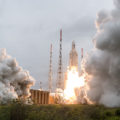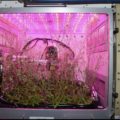Space may seem empty, but it is actually filled with energetic charged particles, controlled by electric and magnetic fields. There is a place between Earth’s atmosphere and space where charged particles touch Earth’s neutral upper layer and this interaction can have a significant impact on radio signals and satellites that provide our communications and GPS systems.
On Jan. 25, NASA has launched a mission to investigate this dynamic intermingling of space and Earth’s uppermost atmosphere and it is the first NASA mission to fly an instrument on a commercial communications satellite.
Dubbed, GOLD or Global-scale Observations of the Limb and Disk, the mission is expected to provide the most comprehensive observations of near-Earth space we’ve ever had. The observations will improve our understanding of the processes involved in near-Earth space and will help protect astronauts, spacecraft and humans on the ground.
“The upper atmosphere is far more variable than previously imagined, but we don’t understand the interactions between all the factors involved,” said Richard Eastes, GOLD principal investigator at the University of Colorado Boulder. “That’s where GOLD comes in: For the first time, the mission gives us the big picture of how different drivers meet and influence each other.”
The zone between Earth and space is a poorly understood region because it is historically difficult to observe. With geostationary orbit over the Western Hemisphere, GOLD will create a full-disk view of the ionosphere and upper atmosphere every half hour and provide detailed large-scale measurements of related processes. This makes GOLD the first mission to monitor the true weather of the upper atmosphere, rather than its overarching climate.
“For years, we’ve studied Earth’s upper atmosphere in detail from the ground and low-Earth orbit. By backing out to geostationary, we can put things in a global context. You can see half the Earth from out there,” said Easters.
So do you like to read such articles , consider liking our page on Facebook here , following us on Twitter here ,or if you love some visual treatment , we make some high quality videos on YouTube as well which you can view here . have a great day :). Visit our hompage HERE for the LATEST SCIENCE NEWS.




